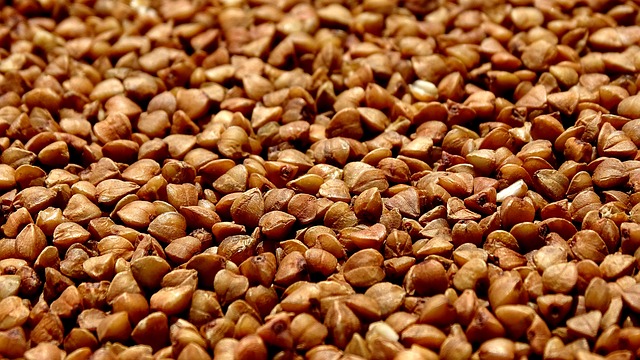
Buckwheat (Family: Polygonaceae ) is a valuable food crop that is eaten and used as an ingredient similar to cereals. It is all about the seed ! It’s been used in breads, noodles and other baked products for millennia. The crop was grown extensively throughout Europe from about the 13th Century onwards. In the 1700s, the crop was replaced by wheat and other cereals. There is renewed interest in the crop because of its use in traditional foods and regional products. Further interest has been generated by its high nutritional value and as a highly valuable gluten free source for those with coeliac diseases (Bonafaccia et al., 2003; Christa & Soral-Smietana, 2008; Gorinstein et al., 2008). There are a number of applications which describe its use in various baked and pasta or noodle products (Bonafaccia and Kreft, 1994).

There are two main species in wide cultivation with a few others left to more specialist agronomy. The Common Buckwheat (Fagopyrum esculentum Moench) in grown in most of Europe, China, the USA and Canada. The Tartary Buckwheat (Fagopyrum tataricum Gaertn.) is grown in Eastern Asia. The seeds produce a starch and dietary fibre. The proteins have a nutritional value and amino-acid profile exceeding the cereal proteins (Bonafaccia et al., 2003). Buckwheat has a high flavonoid content and is especially rich in the levels and type of polyphenols (Oomah & Mazza, 1996; Dietrych-Szóstak & Oleszek, 1999; Christa & Soral-Śmietana, 2008).
Antioxidant Benefits
Buckwheat has been ascribed various health benefits such as lowering blood pressure and cholesterol levels, reducing cancer incidence and controlling blood sugar levels.
Some of those functional benefits can be ascribed to its antioxidant properties. The antioxidant properties were investigated by a team at Rutgers University in New Brunswick, USA, using the Rancimat method, the β-carotene bleaching assay, and a 2,2-diphenyl-β-picrylhydrazyl (DPPH) assay. A methanol extract had the highest antioxidant activity coefficient (AAC) of 627 ± 40 at 200 mg/l by the β-carotene bleaching method and longest induction time of 7.0 ± 0.2 h by the Rancimat method (Sun and Ho, 2005). That study supported earlier research which ascribed the antioxidant activity to a number of phenolics such as rutin (Holasova et al., 2002). Buckwheat derivatives provide a varying amount of rutin (Kreft et al., 2006). The leaf flour contains 2.7g/kg of rutin. The highest content in a food product is found in raw groats (230 mg/kg dry weight) then dark, unrefined flour (218 mg/kg dry weight), and noodles (78 mg/kg dry weight). Very little finds its way into beer which is typical of beverage-fermented products. It also has the ability to minimise the toxicity of certain metals such as aluminium in the soil (Ma et al., 1997). It releases oxalic acid from its roots to form a non-toxic aluminium-oxalate complex which it stores in its leaf cells.
Buckwheat sprouts
One development which is associated with malting is the production of seed sprouts – now a popular healthy addition to salads in both Europe, Asia and the USA. Buckwheat sprouts, with their high flavonoid content including rutin, anthocyanins, proanthocyanidins and other phenolic acids are acquiring a very healthy signature. The rutin content in the sprouts is higher than in the seeds as well as retaining a high lysine amino-acid content, various minerals and dietary fibre (Kim et al., 2004). The main anthocyanins are cyanidin-3-galactoside in Chinese and Nepalese cultivars whilst the galactosyl-rhamnoside derivative is found in Japanese and Russian cultivars (Kim et al., 2007).
References
Bonafaccia, G., Kreft, I. (1994). Technoloical and qualitative characteristics of food products made with buckwheat. Fagopyrum 14, pp.35–42.
Bonafaccia, G., Marocchini, M. & Kreft, I. (2003). Composition and technological properties of the flour and bran from common and tartary buckwheat. Food Chemistry, 80 pp. 9–15.
Christa, K., Soral-Śmietana, M. (2008). Buckwheat grains and buckwheat products – nutritional and prophylactic value of their components – a review. Czech J. Food Sci., 26 pp. 153–162
Dietrych-Szóstak, D., Oleszek, W. (1999). Effect of processing on the flavonoid content in buckwheat (Fagopyrum esculentum Moench) grain. J. Agric. Food Chem., 47, pp. 4384–4387.
Gorinstein, S., Lojek, A., _C_ı_z, M. et al. (2008). Comparison of composition and antioxidant capacity of some cereals and pseudocereals. Int. J. Food Sci. Techn., 43 pp. 629–637
Holasova, M., Fiedlerova, V., Smrcinova, H., Orsak, M., Lachman, J., Vavreinova, S. (2002) Buckwheat – the source of antioxidant activity in functional foods. Food Res. Intern. 35 pp. 207–11.
Kim, S.L., Kim, S.K., Park, C.H. (2004). Introduction and nutritional evaluation of buckwheat sprouts as a new vegetable. FoodRes. Int., 37, pp. 319–327
Kim, S.J., Maeda, T., Sarker, M.Z.I. et al. (2007). Identification of anthocyanins in the sprouts of buckwheat. J. Agric. Food Chem., 55, pp. 6314–6318
Kreft, I., Fabjan, N., Yasumoto, K. (2006) Rutin content in buckwheat (Fagopyrum esculentum Moench) food materials and products. Food Chemistry 98(3) pp. 508-512
Ma, J.F., Zheng, S.J., Matsumoto, H., Hiradate, S. (1997) Detoxifying aluminium with buckwheat. Nature 390 pp. 569-570
Oomah, B.D. & Mazza, G. (1996). Flavonoids and antioxidative activities in buckwheat. J. Agric. Food Chem., 44 pp. 1746-1750
Sun, T., Ho, C-T. (2005) Antioxidant activities of buckwheat extracts. Food Chem., 90 (4) pp. 743-749
Leave a Reply